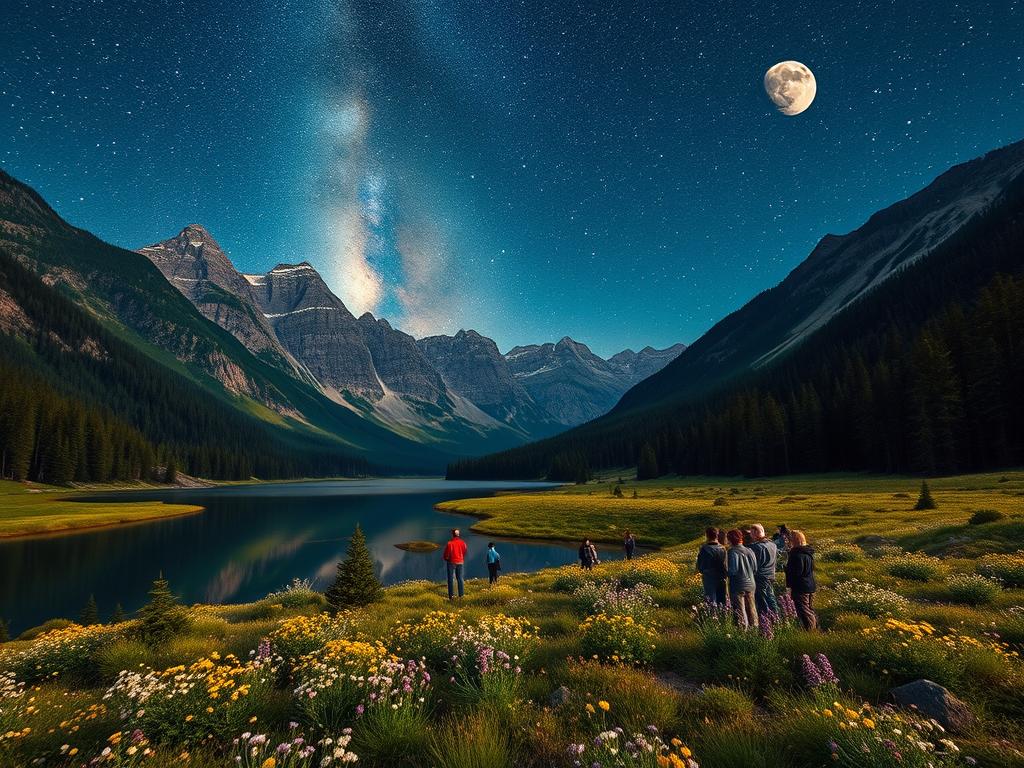Standing under the night sky, I’m amazed by its beauty. Each star whispers to me, asking me to think about our place in the universe. With light pollution growing, finding great stargazing spots is more important than ever.
The magic of astronomy travel is not just seeing stars. It’s about feeling our deep connection to the universe. Places like Big Bend National Park in Texas and Elqui Valley in Chile offer unforgettable views. Are you ready to explore these cosmic adventures and see the wonders above us?
Key Takeaways
- Stargazing offers a unique way to connect with the universe and reflect on our existence.
- Light pollution increasingly threatens our view of the night sky, making dark sky parks vital.
- North America boasts numerous stargazing gems like Big Bend and Death Valley.
- International destinations like Elqui Valley and NamibRand showcase stunning celestial displays.
- Seeking remote locations enhances the experience, allowing us to appreciate the night sky fully.
Introduction to the Magic of Stargazing
Stargazing has always been fascinating, opening doors to the wonders of the universe. Many see it as a spiritual journey, filled with awe and wonder. Looking up at the stars, I remember our ancient connection to the cosmos.
The increasingly precious dark skies
Today, dark skies are rare due to light pollution. The International Dark-Sky Association says over 80% of Americans can’t see the Milky Way from home. This makes it hard to enjoy the night sky and connect with nature.
The role of light pollution in stargazing
Light pollution hides the beauty of the stars. Artificial lights make it hard to see the night sky. To enjoy stargazing, find a dark spot and let your eyes adjust. Use star charts or apps to help find constellations.
Best places for stargazing in North America
North America is full of amazing spots for stargazing. Many national parks across the continent are perfect for this. They have dark skies, free from city lights, making them great for seeing the stars.
Big Bend National Park, Texas
Big Bend is known for its dark skies, making it a top dark sky park in the U.S. It’s in the Chihuahuan Desert, with some of the darkest skies in the country. Stargazers can see constellations and meteor showers clearly. The Milky Way shines brightly here, giving a unique experience.
Acadia National Park, Maine
Acadia has a variety of landscapes for stargazing, like Cadillac Mountain and Jordan Pond. It hosts the Night Sky Festival, connecting visitors with the universe. Its natural beauty and low light pollution make it a top spot in the Northeast for stargazing.
Death Valley National Park, California
Death Valley is the largest national park in the contiguous U.S. and is a Gold Tier International Dark Sky Park. Its dry climate and remote location mean less light pollution. Visitors can see the Milky Way on clear nights. Guided astronomy events are often available, welcoming all to enjoy the night sky.

International Stargazing Destinations
The search for amazing views of the stars takes us to the world’s top spots. These places offer incredible chances for stargazing, each with its own special feel. They draw both new and experienced star watchers.
Elqui Valley, Chile
The Elqui Valley is a Dark Sky Sanctuary in Chile, known for its high altitude and little light pollution. It’s perfect for those who love the stars. With clear skies, visitors can see stars, clusters, and galaxies far away.
Going there can make you love the night sky and the universe’s secrets even more.
NamibRand Nature Reserve, Namibia
The NamibRand Nature Reserve is a top spot for stargazing. It’s a Gold Tier International Dark Sky Reserve with some of the darkest skies. Visitors can go on stargazing safaris to see the southern stars and the Milky Way.
This place shows how beautiful nature and the stars can be together.
La Palma, Spain
La Palma, in the Canary Islands, is known for its strict light pollution rules. It has many trails to observatories, making it a great place to explore. La Palma lets you see the cosmos in a clear and bright way.
Conclusion
Reflecting on stargazing in national parks and international spots, it’s clear these places offer a break from city lights. They let us see the stars and the universe’s grandeur. Places like Big Bend National Park and the Central Idaho Dark Sky Reserve show us the beauty of dark skies.
Light pollution is a big problem that makes it hard to see the night sky. Groups like the International Dark-Sky Association (IDA) fight to save these amazing spots. They want us to see the stars and feel connected to nature.
Stargazing is possible anywhere, from remote parks to local spots. By finding places with little light pollution, we can enjoy the night sky. Let’s work together to keep our skies dark for future generations to enjoy.
